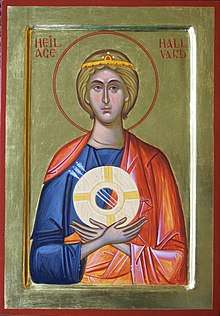Hallvard Vebjørnsson
| Saint Hallvard Hallvard Vebjørnsson | |
|---|---|
 Saint Hallvard is depicted in the seal of the city of Oslo, holding the millstone and arrows used to kill him, with the woman he defended at his feet | |
| Born |
c. 1020 Lier, Buskerud, Norway |
| Died | 1043 |
| Venerated in | Roman Catholic Church Orthodox Church |
| Feast | May 15 |
| Patronage | patron saint of Oslo |
Hallvard Vebjørnsson (Hallvard Den Hellige) (c. 1020 – 1043), commonly referred to as Saint Hallvard (Sankt Hallvard), was the patron saint of Oslo. He is considered a martyr because of his defence of an innocent thrall woman. His religious feast day is 15 May.
The connection of St. Hallvard to the city of Oslo was evidenced by the fact that his image was recorded in the city's seal since the Middle Ages. The municipality's highest honor, the St. Hallvard Medal (St. Hallvard-medaljen), was named after him in 1950. [1]
Background
Little is known of his life, and all traditional stories relate to his death near Drammen. Although the exact year of birth and place of his birth are unknown, he is commonly believed to have been born ca. 1020 According to tradition, his father was the farmer Vebjørn. His parents were wealthy farmers and owned the farm Husaby in Lier. His mother, Torny Gudbrandsdatter, was reportedly related to St. Olaf, the patron saint of Norway. It is said that she was the daughter of Gudbrand Kula from Oppland, who was also the father of Åsta Gudbrandsdatter, St. Olaf's mother.[2]

Death
Hallvard defended a pregnant woman, most likely a thrall, who had been given sanctuary from three men accusing her of theft. Hallvard believed in her innocence and took her on his boat. Hallvard, together with the woman, were killed by arrows from the men. The woman was buried on the beach. Hallvard, however, was bound with a millstone around his neck, and the men attempted to drown his body in Drammensfjord but it refused to sink and as a result their crimes were discovered. A local village buried him in a Christian manner and people came to regard him as a martyr to their faith. [3]
Veneration
St. Hallvard's Cathedral (Hallvardskatedralen) in Oslo was dedicated to his name and his remains were relocated to the facility which was finished in 1130.
The Cathedral was built on the hill just north of the area that is now the Old Town market square in Oslo (intersection of Bispegata –Oslo gate). For almost 500 years this was the most important church in the city. Besides being the bishop's seat and religious center, the cathedral was the coronation church, the royal wedding church and the royal burial chapel. The facility was in use as a church until about 1655. It fell into disrepair in the 17th century and is today a ruin situated in Minneparken.[4] [5][6] [7]

References
- ↑ Anne Stensvold. "Hallvard – norsk helgen". Store norske leksikon. Retrieved September 1, 2017.
- ↑ Vera Henriksen. "Hallvard Den Hellige, helgen". Norsk biografisk leksikon. Retrieved September 1, 2017.
- ↑ "St. Hallvard". lokalhistoriewiki.no. Retrieved September 1, 2017.
- ↑ "Aerial view of the church ruins showing its original shape and size". Retrieved 2012-06-16.
- ↑ "Bispegata (Oslo)". lokalhistoriewiki.no. Retrieved September 1, 2017.
- ↑ "Oslo gate". lokalhistoriewiki.no. Retrieved September 1, 2017.
- ↑ "Hallvardskatedralen". lokalhistoriewiki.no. Retrieved September 1, 2017.